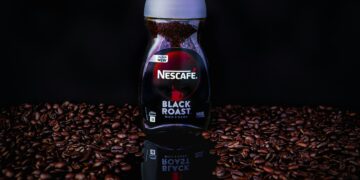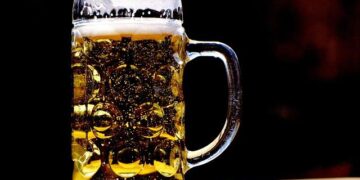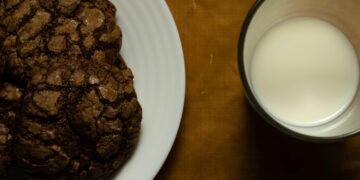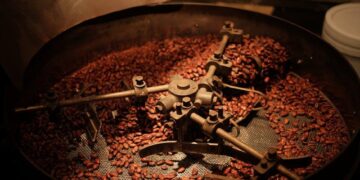Table of Contents
I remember the first time I tasted a truly great cold brew.
It wasn’t just coffee; it was an experience.
Incredibly smooth, with a deep, chocolatey sweetness and none of the harsh, acidic bite I associated with iced coffee.1
I was hooked.
Like so many others, I was captivated by the promise of recreating this magical, low-acid elixir in my own kitchen.3
The internet made it sound so simple.
Every blog, every forum, every coffee enthusiast repeated the same mantra: “Just grind it coarse.”.2
So, I followed the rules.
I bought beautiful, freshly roasted beans from a local roaster—the kind with tasting notes that read like a dessert menu.
I measured my coffee-to-water ratio with precision, often starting with a standard 1:8 concentrate.6
I let it steep for a full 18 hours, filled with anticipation.
And the result? It was a disaster.
My first few batches were heartbreakingly bad.
Instead of a clean, smooth brew, I got a murky, sludgy liquid that was somehow both aggressively bitter and disappointingly weak.8
Tiny particles of coffee “mud” settled at the bottom of my cup, creating a gritty texture that made the last sip undrinkable.11
I had followed the “standard advice” to the letter, yet my expensive beans had been transformed into something I could barely stomach.
It wasn’t just a bad cup of coffee; it was a frustrating mystery that made me question the very foundation of what I thought I knew.
The Epiphany: It’s Not a Pile of Rocks, It’s a Riverbed
For weeks, I was stuck on the oversimplified mantra of “grind coarse.” It felt like being told the secret to baking a perfect cake is to “use flour.” It’s not wrong, but it’s dangerously incomplete.
It tells you the destination without giving you the map.
My frustration led me down a rabbit hole of research, but the real turning point came from a place I never expected: a documentary about river dynamics.
As I watched the water flow, it hit me.
I had been thinking of my coffee grounds as a simple pile of rocks.
But a bad grind isn’t a pile of rocks; it’s more like unstable soil—a chaotic mix of giant boulders, sharp gravel, and fine, silty dust.
Water doesn’t flow through that evenly.
It carves channels, bypasses entire sections, and turns the fine dust into mud that clogs everything up.11
My epiphany was this: You’re not just grinding coffee; you are engineering a riverbed. You are creating the very foundation through which water will slowly and gently extract flavor over many hours.
The process of cold brew extraction isn’t a forceful flood like espresso; it’s a slow, gentle process of diffusion, where flavor molecules gradually move from an area of high concentration (the coffee grounds) to an area of low concentration (the water).14
For that to happen effectively, the riverbed needs to be engineered for perfect flow.
This realization gave me a whole new way to see the problem.
Achieving the perfect cold brew grind isn’t about a single setting; it’s about understanding and controlling a system.
I call it the “Grind-as-a-System” framework, and it rests on three core pillars: Uniformity, The Grinder (Your Engineer), and Dialing In (Reading the River).
Pillar 1: The Principle of Uniformity—Why a Chaotic Riverbed Ruins Your Coffee
To understand why a uniform “riverbed” is so critical, we first have to understand the science of extraction.
When water meets coffee, it begins to dissolve hundreds of different flavor compounds, but they don’t all come out at once.
It happens in stages.16
First to extract are the acids and fruity, floral notes.
If you stop the brew too early, this is all you get, which is why under-extracted coffee tastes sour.9
Next come the sugars, caramels, and chocolatey notes—this is the balanced, sweet spot we’re all aiming for.
Last to extract are the heavy, bitter compounds.
If you let the brew go for too long, these compounds dominate, and the coffee becomes bitter and astringent.6
This is where grind consistency becomes the hero or the villain of your brew.
An inconsistent grind creates two distinct populations of particles that sabotage your extraction from opposite ends: “fines” and “boulders.”.10
Fines and Boulders: The Twin Villains of Inconsistency
- Fines as Silt and Mud: “Fines” are the microscopic coffee particles, like dust or silt. Because they are so tiny, they have a massive collective surface area, which means they extract incredibly fast.9 They race past the sweet spot and release their bitter compounds long before the larger particles have even started to properly brew.20 Worse, these fines clog the spaces between the larger grounds and can even pass through your filter, creating that dreaded “mud” or “sludge” at the bottom of your cup and a gritty mouthfeel.8 They effectively create dams and mudslides in your riverbed, preventing water from flowing evenly.
- Boulders as, well, Boulders: “Boulders” are the oversized chunks in an inconsistent grind. They are the opposite problem. Because of their large size and low relative surface area, the slow process of diffusion can’t effectively penetrate to their core within the 12 to 24-hour brew time.14 Water flows right past them, leaving their desirable sweet and complex flavors locked inside. This leads to under-extraction, resulting in a brew that tastes weak, watery, hollow, and often sour.9
This understanding solves a common and frustrating mystery: how a single cup of cold brew can taste both bitter and sour at the same time.
Standard coffee advice often presents bitterness and sourness as opposite ends of a single spectrum—if it’s bitter, you extracted too much; if it’s sour, you extracted too little.9
But this doesn’t account for the confusing experience of tasting both flaws at once, a common complaint in online forums.22
The culprit is a non-uniform grind.
You are simultaneously tasting the over-extracted bitterness from the fines and the under-extracted sourness from the boulders.
Your final cup is not one brew, but a messy, unbalanced collision of two poorly extracted coffees.
The goal, therefore, is not just to aim for an average size, but to eliminate the extremes by achieving uniformity.
Pillar 2: The Grinder—Your Extraction Engineer
If the goal is to create a uniform riverbed of perfectly sized pebbles, then your grinder is the engineer responsible for the job.
I can say without a doubt that upgrading my grinder was the single most impactful change I made on my journey to perfect cold brew.
There are two main types of grinders, and they produce dramatically different results.
Blade Grinders: The Chaos Creators
A blade grinder doesn’t really grind; it pulverizes.
It uses a spinning blade, much like a blender, to smash and shatter coffee beans into pieces.24
This violent, chaotic process is fundamentally incapable of producing a consistent particle size.
The result is the exact mix of fines and boulders we want to avoid.9
Furthermore, the high-speed friction of the blade generates a surprising amount of heat, which can start to “cook” the beans, releasing precious volatile aromas and introducing bitter flavors before you’ve even added water.23
Burr Grinders: The Architects of Order
A burr grinder, in contrast, is a tool of precision.
It works by feeding beans between two abrasive surfaces, or “burrs,” one of which is stationary while the other rotates.
The beans are crushed and cut into a specific size determined by the gap between the burrs, which you can adjust.26
This controlled, mechanical process creates a much more consistent and uniform particle size, allowing you to build that ideal “riverbed” for clean, balanced, and predictable extraction.8
While there are different types of burrs (conical and flat), both are vastly superior to blades for achieving the uniformity that cold brew demands.24
To make the choice clear, here is a direct comparison of how each grinder type performs in the context of making cold brew.
| Feature | Blade Grinder | Burr Grinder |
| Grinding Mechanism | Pulverizing/Smashing with a spinning blade.24 | Controlled cutting/crushing between two adjustable burrs.26 |
| Grind Consistency | Highly Inconsistent. Produces a wide range of particle sizes.9 | Highly Consistent. Produces a narrow range of uniform particles.10 |
| Resulting “Riverbed” | A chaotic mix of “mud” (fines) and “boulders” (coarse chunks). | A uniform bed of consistently sized “pebbles.” |
| Heat Generation | High. Significant heat from friction can “cook” the grounds.23 | Low / Minimal. Preserves the delicate aromas of the coffee.25 |
| Flavor Impact | Prone to bitter, sour, and muddled flavors with a sludgy texture.17 | Produces a clean, sweet, smooth, and balanced flavor profile. |
| Best For | Grinding spices. Not recommended for quality coffee brewing. | Achieving predictable, high-quality coffee for any brew method. |
Investing in a quality burr grinder doesn’t have to break the Bank. Excellent entry-level models like the Baratza Encore or the OXO Brew Conical Burr Grinder offer fantastic consistency for their price point, while higher-end models like the Breville Smart Grinder Pro provide even more precision.28
This single piece of equipment is the key to moving from frustrating guesswork to consistent success.
Pillar 3: Dialing In—How to Read the River and Find Your Perfect Grind
With an understanding of why uniformity matters and what tool you need, we can finally tackle the how.
This is the practical guide to finding the perfect grind setting for your specific beans and setup.
This is where you move from following rules to actively creating your perfect cup.
Step 1: Establish a Visual and Tactile Baseline
Let’s get more specific than just “coarse.” For cold brew, you are aiming for a grind that visually resembles coarse sea salt, raw sugar, or cracked peppercorns.8
When you rub it between your fingers, it should feel distinctly gritty and chunky, not sandy or powdery like you would use for drip coffee.8
Most burr grinders will label this setting as “Coarse” or place it near the setting for a French Press. This is your starting point.
Step 2: The Controlled Experiment—Your First Success Story
To dial in your grind, you must conduct a controlled experiment.
This means you only change one variable at a time.
For your first attempt with your burr grinder, lock in the other variables:
- Ratio: Use a 1:8 ratio by weight (e.g., 100 grams of coffee to 800 grams of water) for a solid concentrate.8
- Water: Always use filtered water. Your coffee is over 98% water, and impurities in tap water will negatively affect the flavor.2
- Time & Temp: Steep for 16-18 hours at room temperature. This is a great baseline that avoids the extra-long steep times required in the fridge.6
Set your grinder to that “coarse sea salt” texture, brew your batch, and then taste it.
This first successful brew, free from the sludge and chaos of a blade grinder, is a revelation.
But we can refine it even further.
Step 3: Tasting and Troubleshooting—Reading the Signs
Your taste buds are your most important diagnostic tool.
By learning to identify the key flavor notes in your brew, you can understand what your “riverbed” is telling you and make precise adjustments.
The following table is your diagnostic guide for perfecting your cold brew.
| If Your Cold Brew Tastes… | Your “Riverbed” is… (The Cause) | The Solution (The Fix) |
| Bitter, Harsh, Astringent | Over-extracted. Your grind is likely too fine, or your grinder is producing too many “fines” (silt). These small particles are giving up their bitter compounds too quickly.10 | Grind Coarser. On your next batch, adjust your burr grinder one or two steps coarser. You can also try shortening the steep time by 2-4 hours.17 |
| Weak, Watery, Thin, Hollow | Under-extracted. Your grind is too coarse, creating “boulders” that the water can’t fully penetrate. The good flavors are still locked inside the grounds.21 | Grind Finer. Adjust your grinder to a slightly finer setting. Also, confirm your coffee-to-water ratio is strong enough (at least 1:8) and your steep time is sufficient (at least 12 hours).33 |
| Sour, Unpleasantly Acidic | Under-extracted. This is a classic sign that you’ve extracted the initial sour acids but haven’t steeped long enough to extract the balancing sugars. This is caused by a grind that’s too coarse or a steep time that’s too short.9 | Steep Longer OR Grind Finer. First, try extending your steep time by 4-6 hours. If the next batch is still sour, then adjust your grind to a slightly finer setting.17 |
| Muddy, Gritty, Sludgy | Poor Filtration / Too Many Fines. Your grind is inconsistent, producing excessive “fines” (silt) that are passing through your filter. This is primarily a grinder quality issue.11 | Improve Grind Uniformity & Filtration. This is the signature of a blade grinder; the best solution is to upgrade to a burr grinder. For an immediate fix, you can double-filter your brew—first through a fine-mesh sieve, then through a paper coffee filter. And never squeeze or press the filter bag, as this forces fines into the final brew.2 |
It is crucial to recognize that the ideal grind size is not a universal constant.
It exists as part of an interdependent system with time and temperature.
For example, a grind size that is perfect for a 16-hour steep at room temperature will likely be too coarse for a 24-hour steep in the refrigerator, as the colder temperature slows down extraction.2
If you want to make a faster batch of cold brew, you can’t simply cut the time short; you must compensate by grinding finer to increase the rate of extraction within that shorter window.34
Understanding this interplay is the final step in moving from a static, rule-based approach to a dynamic, systems-based mastery of the process.
You Are the Master of Your Cold Brew System
My journey with cold brew began with frustration.
I was a novice following what seemed like simple rules, only to be met with bitter, sludgy failure.
The breakthrough came when I stopped thinking about a single setting and started thinking about the entire system.
By reframing the process through the “riverbed” analogy, I finally understood the profound importance of grind uniformity.
The secret to amazing cold brew isn’t just to “grind coarse.” It’s to create a consistent, uniform foundation that allows for the slow, gentle, and even extraction of all the sweet, complex flavors your coffee has to offer.
It’s about using the right tool—a burr grinder—to engineer that foundation, and then using your own taste buds to dial it in to perfection.
You now have more than just a recipe; you have a mental model.
You have the knowledge to diagnose your brew, adjust your technique, and create the perfect, smooth, and sweet cold brew that you love, every single time.
You are no longer at the mercy of vague rules.
You are the master of your cold brew system.
Works cited
- Cold Brew or Cold Drip – Goat Story, accessed August 4, 2025, https://goat-story.com/blogs/news/cold-brew-or-cold-drip
- Six Common Mistakes When Making Cold Brew Coffee, accessed August 4, 2025, https://groundsandhoundscoffee.com/blogs/recent-posts/six-common-mistakes-when-making-cold-brew-coffee
- The Beginner’s Guide to Cold Brew Coffee, accessed August 4, 2025, https://waterstreetcoffee.com/blogs/news/the-beginners-guide-to-cold-brew-coffee
- The Ultimate Guide to Making Cold Brew Coffee – Cartel Roasting Co, accessed August 4, 2025, https://cartelroasting.co/the-ultimate-guide-to-making-cold-brew-coffee/
- How To Make Cold Brew Coffee – Simply Recipes, accessed August 4, 2025, https://www.simplyrecipes.com/recipes/how_to_make_cold_brew_coffee/
- How Long To Steep Cold Brew – We Tested, accessed August 4, 2025, https://thatscoldbrew.com/how-long-to-steep-cold-brew/
- An Easy Guide to Making Cold Brew Coffee – INeedCoffee, accessed August 4, 2025, https://ineedcoffee.com/easy-guide-making-cold-brew-coffee/
- How to Grind Coffee for Cold Brew – 4 Easy Step (2025) – Kimbo …, accessed August 4, 2025, https://www.kimbocoffee.com/blogs/kimbo-blog/how-to-grind-coffee-for-cold-brew
- Coffee Grind Size: Which is Right for Your Brew?, accessed August 4, 2025, https://www.coffeebeancorral.com/coffee-grind-size.aspx
- Grind Size Explained: Everything You Need To Know | Weathered …, accessed August 4, 2025, https://www.weatheredhandscoffee.com/blog/grind-size-explained
- The Science of Cold Brew — Blue House Coffee, accessed August 4, 2025, https://bluehousecoffee.com/learn/the-science-of-cold-brew
- Choosing the best cold brew coffee grounds, accessed August 4, 2025, https://www.deathwishcoffee.com/blogs/coffee-talk/what-grounds-to-use-for-cold-brew
- Excruciatingly slow extraction : r/pourover – Reddit, accessed August 4, 2025, https://www.reddit.com/r/pourover/comments/1ac915m/excruciatingly_slow_extraction/
- The Dynamics of Coffee Extraction – Coffee ad Astra, accessed August 4, 2025, https://coffeeadastra.com/2019/01/29/the-dynamics-of-coffee-extraction/
- Diffusion – Wikipedia, accessed August 4, 2025, https://en.wikipedia.org/wiki/Diffusion
- How Coffee Extraction Works – Clive Coffee, accessed August 4, 2025, https://clivecoffee.com/blogs/learn/how-coffee-extraction-works
- Having Trouble With Your Cold Brew Coffee? Here Are 5 Tricks To Try – JavaPresse, accessed August 4, 2025, https://www.javapresse.com/blogs/cold-brew/having-trouble-with-your-cold-brew-coffee-here-are-5-tricks-to-try
- How to Make Cold Brew Less Bitter: 8 Easy Fixes – Foragers of Happiness, accessed August 4, 2025, https://foragersofhappiness.com/how-to-make-cold-brew-less-bitter/
- The Science of Coffee Bean Grinding | Cafe Du Monde, accessed August 4, 2025, https://www.cafedumonde.co.uk/academie/guides/science-of-coffee-bean-grinding/
- Bitter Coffee 101: Why It Happens (+3 Ways To Fix It) – ESPRO, accessed August 4, 2025, https://espro.com/blogs/coffee-talk/bitter-coffee-101-why-it-happens-3-ways-to-fix-it
- What Happens If The Coffee Grind Is Too Coarse? | Pesado 58.5, accessed August 4, 2025, https://pesado585.com/blogs/news/coffee-grind-too-coarse
- Need help troubleshooting making my own coldbrew. – Reddit, accessed August 4, 2025, https://www.reddit.com/r/coldbrew/comments/1kbs544/need_help_troubleshooting_making_my_own_coldbrew/
- Brew is too acidic/bitter. Help! : r/coldbrew – Reddit, accessed August 4, 2025, https://www.reddit.com/r/coldbrew/comments/p5qs8y/brew_is_too_acidicbitter_help/
- Burr Vs. Blade Grinders: Which Is the Best for Coffee? – Serious Eats, accessed August 4, 2025, https://www.seriouseats.com/burr-vs-blade-coffee-grinders-7557180
- Burr Grinder vs. Blade Grinder: Which Makes The Better Coffee? – CoffeeRoast Co., accessed August 4, 2025, https://coffeeroastco.com/blogs/coffee-roast-co-blog/burr-grinder-vs-blade-grinder
- What to Look for When Buying a Coffee Grinder – OutIn, accessed August 4, 2025, https://outin.com/blogs/news/coffee-grinder-buying-tips
- The Importance of Grind Size – North Star Coffee Roasters, accessed August 4, 2025, https://www.northstarroast.com/blogs/brewing/the-importance-of-grind-size
- Electric Coffee Grinders for Coarse Grind | Multiple Settings – Target, accessed August 4, 2025, https://www.target.com/s/coarse+coffee+grinder
- Coffee Grinders for Sale, Best for French Press | FrenchPressCoffee.com, accessed August 4, 2025, https://www.frenchpresscoffee.com/collections/coffee-grinders
- How To Make Cold Brew Coffee | Seven Miles Coffee Roasters, accessed August 4, 2025, https://www.sevenmiles.com.au/blogs/editorial/cold-brew-coffee-guide
- how do you guys make cold brew? : r/Coffee – Reddit, accessed August 4, 2025, https://www.reddit.com/r/Coffee/comments/oi7rm7/how_do_you_guys_make_cold_brew/
- Why your cold brew is weak (and how you can fix it!) – Shelbru, accessed August 4, 2025, https://www.shelbru.com/blogs/blog/why-your-cold-brew-is-weak-and-how-you-can-fix-it
- Cold Brew Troubleshooting – Product Help – KitchenAid, accessed August 4, 2025, https://producthelp.kitchenaid.com/Countertop_Appliances/Coffee_and_Espresso/Product_Info/Coffee_Product_Tips_and_Tricks/Cold_Brew_Troubleshooting
- First attempt at cold brew very weak, what did I do wrong? : r/Coffee – Reddit, accessed August 4, 2025, https://www.reddit.com/r/Coffee/comments/4pa8dy/first_attempt_at_cold_brew_very_weak_what_did_i/
- Cold Brewing (Home-Made) – Q&A – Barista Hustle Community Forum, accessed August 4, 2025, https://community.baristahustle.com/t/cold-brewing-home-made/1066
- Coarse grind for cold brew? : r/Coffee – Reddit, accessed August 4, 2025, https://www.reddit.com/r/Coffee/comments/2ff8af/coarse_grind_for_cold_brew/






